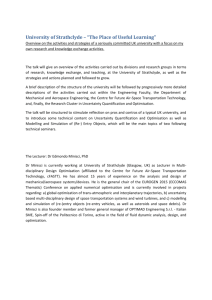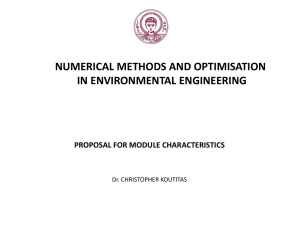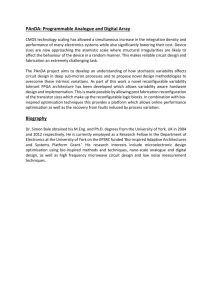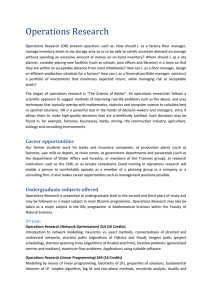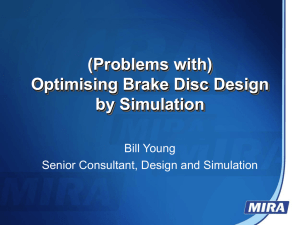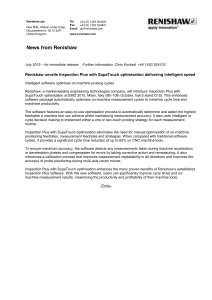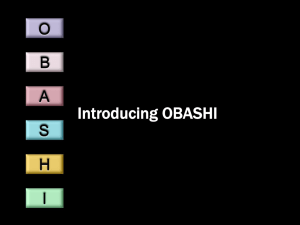Additive Manufacturing Vukile Dumani | 14 July 2014
advertisement
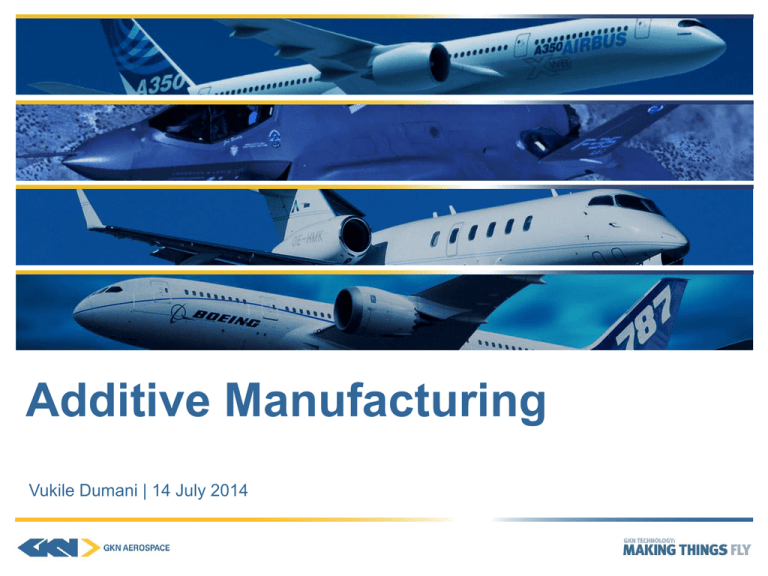
Additive Manufacturing Vukile Dumani | 14 July 2014 GKN PLC: Delivering to our Markets We have four operating divisions: GKN Driveline and GKN Powder Metallurgy that focus on the automotive market; GKN Aerospace, and GKN Land Systems. Every division is a market leader, each outperforming its markets, giving unrivalled expertise and experience in delivering cutting-edge technology and engineering to our global customers: GKN Aerospace A leading first tier supplier to the global aviation industry focussing on aerostructures, engine systems and products and specialty products. GKN Driveline A world leading supplier of automotive driveline systems and solutions, including all-wheel drive. 2013 - Sales by division £104m Other 1% £899m Land Systems 12% GKN Powder Metallurgy The world’s largest manufacturer of sintered components, predominantly to the automotive sector. £3,416m Driveline 45% £2,243m Aerospace 30% GKN Land Systems A leading supplier of technologydifferentiated power management solutions and services to the agricultural, construction, industrial and mining sectors. Powder Metallurgy 12% £932m 2 GKN Aerospace $3.5 billion Global Aerospace company, 35 sites in 9 countries, 11,700 people Market leaders in airframe structures, engine components and transparencies Increasing investment in technology and focus on deployment Growing global footprint as part of drive for increasing competitiveness 3 GKN Aerospace – World Class Product Portfolio Aerostructures Global #3 Engine structures 45% of Sales 2013 50% of Sales 2013 Wing Fuselage Nacelle and Pylon Global #2 Engine Systems and Services Engine structures Engine rotatives Special products Global #1/2 5% of Sales 2013 Transparencies and Protection Systems J-UCAS Fuselage A380 Fixed Trailing Edge B747-8 Exhaust B787 Anti-icing System A350XWB Rear Spar CH53K Aft Fuselage A400M Engine Intake V22 Fuel Tanks A330 Flap Skins B787 Floor Grid B767 Winglet HondaJet Fuselage B787 Cabin Windows B787 Inner Core Cowl Full Engine MRO and support Ariane 5 Exhaust nozzle F35 Canopy 4 A Broad Customer Base Military 27% Civil 73% 2013 Sales 5 Targeted Innovation – Technology Engine Statics Engine Rotatives Future Wing Technologies Advanced Fuselage Composite Technology Metallic Technology Supporting Technology 6 Nacelle, Pylon & Exhaust Transparencies Protection & Coatings Systems Two Ways of Fabrication - Traditional View Subtractive Additive 7 Two Ways of Fabrication - Modern View Subtractive Additive Aircraft Rib Structures ( Source: Cranfield) Aircraft Rib Structures ( Source: Cranfield) 8 Powder Based Technologies Powder Bed Nozzle Deposition Layer Deposition 9 Powder Based Technologies Powder Bed Nozzle Deposition Two Methods: One Method: Electron Beam Melting Direct Metal Deposition Selective Laser Melting 10 Powder Based Technologies Powder Bed Nozzle Deposition Characteristics: Materials Characteristics: 1. Good mechanical properties 2. High part complexity 3. Surface finish 4. Not as precise as SLM 1. High build rate 2. Suitable for repairs 3. High powder utilisation 4. Low part complexity 1. High accuracy 2. High part complexity 3. Low build rate 4. Residual stress 11 Powder Based Technologies Powder Bed Nozzle Deposition Applications: Turbine Blade ( Source:Avio) Applications: Orthopaedic Implants ( Source:Arcam) Blisk Repairs ( Source: Fraunhofer Institute) Lattice Housing (Source:Arcam) Dental Prostheses ( Source:EoS) Laser Cladding (Source: Fraunhofer Institute) Fuel Injector & Swirler Jewellery ( Source:CPM) 12 Metallic Leading Edge ( Source: Fraunhofer Institute) Wire Based Technologies Laser Wire Deposition Electron Beam Wire Deposition 13 Wire Based Technologies Laser Wire Deposition Electron Beam Wire Deposition Characteristics: Characteristics: 1. Relatively fast 2. Good mechanical properties 1. Relatively fast 2. Suitable for repairs 3. Low complexity 3. Low complexity 4. Residual stress 4. Surface finish 14 Wire Based Technologies Laser Wire Deposition Electron Beam Wire Deposition Applications: Applications: Aircraft Rib Structures ( Source: Cranfield) Aircraft Rib Structures ( Source: Cranfield) Aircraft Rib Structures ( Source: Cranfield) Aircraft Rib Structures ( Source: Cranfield) Aircraft Rib Structures ( Source: Cranfield) 15 Why Use Additive Manufacturing? Additive Manufacturing saves significant resources over current methods: raw materials, energy, fewer chemicals (cutting fluids), lead time = cost 20:1 Buy-to-Fly Forged Billet =200kg Finished Part = 10kg Swarf = 190kg 2:1 Buy-to-Fly Baseplate=10kg Wire = 10kg Swarf = 10kg Finished Part = 10kg 16 Barriers to Implementation Qualification barriers Many variables require standardisation Material allowables need to be generated for the different process variables Each machine may produce unique characteristics that increase process variability Material properties may vary from process to process, machine to machine, location to location and orientation to orientation Raw material cost may be reduced by Mass production Cheaper manufacturing methods Cheaper sources such as swarf Process speed On-going research is aiming to improve this Design and analysis tools Requires a change of mind-set from traditional design Machine cost Limited number of suppliers will improve as new players come onto the market 17 Optimisation in Aerospace Design Farnborough International Airshow 2014 Wilson Wong | 14 July 2014 Author Wilson Wong Design and Analysis Lead – Additive Manufacturing Centre Background: − MEng Aeronautical Engineering, University of Bristol − Phd Composite Buckling, University of Bristol − Design / Structural / FEA engineer − Assystem, Atkins − GKN Aerospace – Additive Manufacturing Centre Interests: − Novel methods on design and analysis − Exploration of advance design and analysis techniques − Incorporating latest IT advancement in the design and analysis process 19 20 Definition of Optimisation From Latin optimus (best) Cambridge dictionary: The act of making something as good as possible Oxford dictionary: “Make the best or most effective use of (a situation or resource)” What does it really entail? 21 We Carry Out Optimisation in Different Scenarios Route optimisation (travelling salesman problem) Online presence optimisation (inc. Search Engine Optimisation and Social Media Optimisation) Priority identification Process optimisation Space optimisation (Source: CiS) Task planning / resource optimisation (Source: http://www.iprod-project.eu/) 22 Project planning Outcome Cost Route optimisation (travelling salesman problem) Online presence optimisation (inc. Search Engine Optimisation and Social Media Optimisation) Quality Priority identification Optimisation Performance Process optimisation Time Space optimisation (Source: CiS) Task planning / resource optimisation (Source: http://www.iprod-project.eu/) 23 Project planning Outcome Cost Route optimisation (Travelling salesman problem) Online presence optimisation (inc. Search Engine No tooling – reduce cost, Optimisation & Social Media Optimisation) Quality Optimisation time Performance Reduce waste Priority identification New design freedom to increase performance Process optimisation Rapid response to modification Time Space optimisation (Source: CiS) Task planning / resource optimisation (Source: http://www.iprod-project.eu/) 24 Project planning AM and Optimisation – Relationship 25 Current State of the Art – 2D/2.5D Structural Optimisation Source: Airbus, Altair Source: Boeing, Desktop Engineering Source: Eurocopter, Altair Source: Airbus, Technische Universität München 26 Current Examples – 3D Structural Optimisation (Enabled by AM) Source: EADS Apworks GmbH, Altair Source: Within Lab Source: GE Source: Airbus, Altair Source: EADS Innovation Works, Altair Source: GE, GrabCAD Source: GKN Source: GKN, Airbus 27 AM Facilitates Optimisation With machining constraints Without machining constraints 28 Structural Optimisation – Future 29 Structural Optimisation - Macro Topology, Size, Shape Topology Size Topography Shape Free-Size Free-Shape Concept Refine Lattice + Skin (Size, Shape) Source: LimitState Source: Within Lab Source: USTC, DUT, MRA Source: GE, GrabCAD Source: DTI 30 Structural Optimisation - Meso Combine features of topology and lattices Reduces mass of topology optimised structure further Provide robustness of features in topology optimised structure Source: Delta 7 Source: DTI, Compolight Source: Altair 31 Structural Optimisation - Micro Mimic nature (bio-mimetic), e.g. bone Design material at micro scale to cater for properties required Source: MIT, LLNT Source: BBC, 3ders.org Source: HRL Laboratories LLC 32 Optimisation Unleashes Potential of AM With machining constraints Without machining constraints 33 Challenges Design More integrated/easy modelling software required Software to handle exponential amount of geometries Analysis New analysis methods needed Significantly better solver capability Manufacturing Speed Reliability Inspection New techniques required Post processing New techniques required Testing New test methodology needed • • • • Process change Mindset change Development of new methods IT backbone to support Culture change 34 Development Process Flow Conventional Customer Requirements Concept Detail Analysis (Stress, F&DT) Detail Design Design Customer Requirements Future Final Design Detail Design Optimisation Concept Local Detail Analysis (Stress, F&DT) Analysis Global 35 Final Design Current Topology optimisation CFD optimisation Configuration optimisation Source: GE, GrabCAD Multi-physics optimisation Source: Airbus, Altair Source: RR 36 Different Aspects of Aircraft Design Source: McGill University Source: Technishe Universitat Braunschweig Source: Antonio Silva Source: Linflow Source: MOOG, NI Source: ANSYS Source: MSC 37 GOAL - Holistic Optimisation MDO for Aircraft Configurations with High-fidelity (MACH) 38 GOAL - Holistic Optimisation Multi-level of details •Top level approximate system modelling •Low level detail modelling Accessible to every stakeholder •Bidding team •Detail analyst Allow quick what-if scenarios at any time offline •Impact analysis on changes 39 Why Are We Not Using Global Optimisation More? Challenges Barriers Big data – data management Specialist software Computing power Very specific technical skills needed Physics coupling complex Much greater complexity of problems Different software platforms Steep learning curve Paradigm shift in mindset, culture, working procedures Embedded culture 40 Possible Solutions Analytics method − − − − Multivariate analysis Design of Experiment Design Structural Matrix Parallel Coordinate HPC, distributed computing, Cloud Multi-scale analysis Source: EnterpriseTech Cloud Edition Custom code to interconnect different platforms Simplistic software for quick approximate answer Source: NASA 41 In Brief AM Optimisation What is optimisation? Emphasis on structural optimisation (now and future) Challenges ahead for implementing future structural optimisation Importance of culture Local and global optimisation Challenges on global optimisation Quick peek to future 42 Future and Questions Source: Emerging Objects Source: Airbus Source: Henri Freiherr von Freyberg Source: Altair Source: MIT Source: Concept Laser Source: EDAG, 3ders Source: Aerojet Rocketdyne 43 Source: Dame Zaha Hadid
